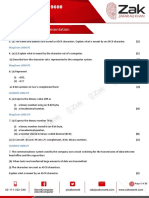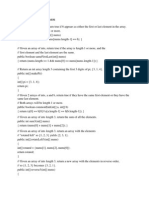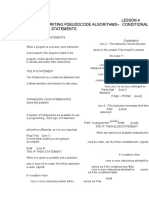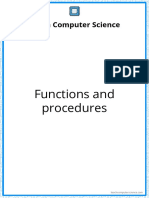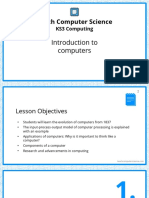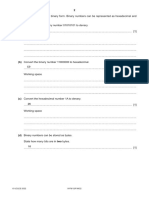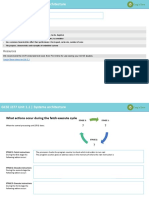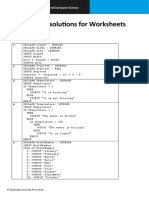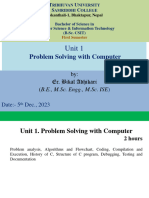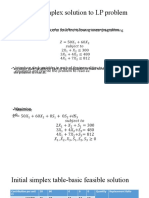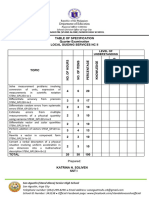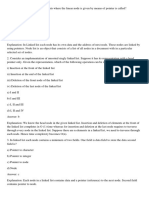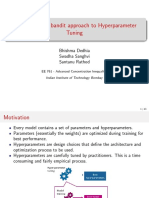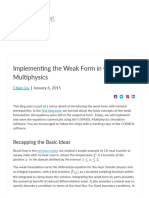Tutorial #6
PseudoCode (reprise)
Program Design
�Pseudocode
The first thing we do when designing
a program is to decide on a name for
the program.
�Pseudocode
The first thing we do when designing
a program is to decide on a name for
the program.
Lets say we want to write a program
to calculate interest, a good name for
the program would be
CalculateInterest.
�Pseudocode
The first thing we do when designing
a program is to decide on a name for
the program.
Lets say we want to write a program
to calculate interest, a good name for
the program would be
CalculateInterest.
Note the use of CamelCase.
�Pseudocode
The first thing we do when designing
a program is to decide on a name for
the program.
Lets say we want to write a program
to calculate interest, a good name for
the program would be
CalculateInterest.
Note the use of CamelCase.
�Pseudocode
So we start the program as:
PROGRAM CalculateInterest:
�Pseudocode
So we start the program as:
PROGRAM CalculateInterest:
And in general its:
PROGRAM <ProgramName>:
�Pseudocode
Our program will finish with the
following:
END.
�Pseudocode
Our program will finish with the
following:
END.
And in general its the same:
END.
�Pseudocode
So the general structure of all
programs is:
PROGRAM <ProgramName>:
<Do stuff>
END.
�SEQUENCE
�Pseudocode
When we write programs, we assume
that the computer executes the
program starting at the beginning
and working its way to the end.
This is a basic assumption of all
algorithm design.
�Pseudocode
When we write programs, we assume
that the computer executes the
program starting at the beginning
and working its way to the end.
This is a basic assumption of all
algorithm design.
We call this SEQUENCE.
�Pseudocode
In Pseudo code it looks like this:
Statement1;
Statement2;
Statement3;
Statement4;
Statement5;
Statement6;
Statement7;
Statement8;
�Pseudocode
For example, for making a cup of tea:
Organise everything together;
Plug in kettle;
Put teabag in cup;
Put water into kettle;
Wait for kettle to boil;
Add water to cup;
Remove teabag with spoon/fork;
Add milk and/or sugar;
Serve;
�Pseudocode
Or as a program:
PROGRAM MakeACupOfTea:
Organise everything together;
Plug in kettle;
Put teabag in cup;
Put water into kettle;
Wait for kettle to boil;
Add water to cup;
Remove teabag with spoon/fork;
Add milk and/or sugar;
Serve;
END.
�Pseudocode
Or as a program:
PROGRAM MakeACupOfTea:
Organise everything together;
Plug in kettle;
Put teabag in cup;
Put water into kettle;
Wait for kettle to boil;
Add water to cup;
Remove teabag with spoon/fork;
Add milk and/or sugar;
Serve;
END.
�SELECTION
�Pseudocode
What if we want to make a choice,
for example, do we want to add
sugar or not to the tea?
�Pseudocode
What if we want to make a choice,
for example, do we want to add
sugar or not to the tea?
We call this SELECTION.
�Pseudocode
So, we could state this as:
IF (sugar is required)
THEN add sugar;
ELSE dont add sugar;
ENDIF;
�Pseudocode
Or, in general:
IF (<CONDITION>)
THEN <Statements>;
ELSE <Statements>;
ENDIF;
�Pseudocode
Or to check which number is biggest:
IF (A > B)
THEN Print A + is bigger;
ELSE Print B + is bigger;
ENDIF;
�Pseudocode
Adding a selection statement in the program:
PROGRAM MakeACupOfTea:
Organise everything together;
Plug in kettle;
Put teabag in cup;
Put water into kettle;
Wait for kettle to boil;
Add water to cup;
Remove teabag with spoon/fork;
Add milk;
IF (sugar is required)
THEN add sugar;
ELSE do nothing;
ENDIF;
Serve;
END.
�Pseudocode
Adding a selection statement in the program:
PROGRAM MakeACupOfTea:
Organise everything together;
Plug in kettle;
Put teabag in cup;
Put water into kettle;
Wait for kettle to boil;
Add water to cup;
Remove teabag with spoon/fork;
Add milk;
IF (sugar is required)
THEN add sugar;
ELSE do nothing;
ENDIF;
Serve;
END.
�ITERATION
�Pseudocode
What if we need to tell the computer
to keep doing something until some
condition occurs?
�Pseudocode
What if we need to tell the computer
to keep doing something until some
condition occurs?
Lets say we wish to indicate that the
you need to keep filling the kettle
with water until it is full.
�Pseudocode
What if we need to tell the computer
to keep doing something until some
condition occurs?
Lets say we wish to indicate that the
you need to keep filling the kettle
with water until it is full.
We need a loop, or ITERATION.
�Pseudocode
So, we could state this as:
WHILE (Kettle is not full)
DO keep filling kettle;
ENDWHILE;
�Pseudocode
Or, in general:
WHILE (<CONDITION>)
DO <Statements>;
ENDWHILE;
�Pseudocode
Or to print out the numbers 1 to 5:
A = 1;
WHILE(A > 5)
DO Print A;
A = A + 1;
ENDWHILE;
�Pseudocode
What is the benefit of using a loop?
�Pseudocode
Consider the problem of searching
for an entry in a phone book with
only condition:
�Pseudocode
Consider the problem of searching for an
entry in a phone book with only condition:
Get first entry
If this is the required entry
Then write down phone number
Else get next entry
If this is the correct entry
then write done entry
else get next entry
if this is the correct entry
.
�Pseudocode
This could take forever to specify.
�Pseudocode
This could take forever to specify.
There must be a better way to do it.
�Pseudocode
We may rewrite this as follows:
Get first entry;
Call this entry N;
WHILE N is NOT the required entry
DO Get next entry;
Call this entry N;
ENDWHILE;
�Pseudocode
We may rewrite this as follows:
Get first entry;
Call this entry N;
WHILE N is NOT the required entry
DO Get next entry;
Call this entry N;
ENDWHILE;
This is why we love loops!
�Pseudocode
Or as a program:
PROGRAM MakeACupOfTea:
Organise everything together;
Plug in kettle;
Put teabag in cup;
WHILE (Kettle is not full)
DO keep filling kettle;
ENDWHILE;
Wait for kettle to boil;
Add water to cup;
Remove teabag with spoon/fork;
Add milk;
IF (sugar is required)
THEN add sugar;
ELSE do nothing;
ENDIF;
Serve;
END.
�Pseudocode
Or as a program:
PROGRAM MakeACupOfTea:
Organise everything together;
Plug in kettle;
Put teabag in cup;
WHILE (Kettle is not full)
DO keep filling kettle;
ENDWHILE;
Wait for kettle to boil;
Add water to cup;
Remove teabag with spoon/fork;
Add milk;
IF (sugar is required)
THEN add sugar;
ELSE do nothing;
ENDIF;
Serve;
END.
�EXAMPLES
�Pseudocode
So lets say we want to express
the following algorithm:
Read in a number and print it out.
�Pseudocode
PROGRAM PrintNumber:
Read A;
Print A;
END.
�Pseudocode
So lets say we want to express
the following algorithm:
Read in a number and print it out double
the number.
�Pseudocode
PROGRAM PrintDoubleNumber:
Read A;
B = A*2;
Print B;
END.
�Pseudocode
So lets say we want to express
the following algorithm:
Read in a number, check if it is odd or
even.
�Pseudocode
PROGRAM IsOddOrEven:
Read A;
IF (A/2 gives a remainder)
THEN Print Its Odd;
ELSE Print Its Even;
ENDIF;
END.
�Pseudocode
So lets say we want to express
the following algorithm to print
out the bigger of two numbers:
Read in two numbers, call them A and B. Is
A is bigger than B, print out A, otherwise
print out B.
�Pseudocode
PROGRAM PrintBiggerOfTwo:
Read A;
Read B;
IF (A>B)
THEN Print A;
ELSE Print B;
ENDIF;
END.
�Pseudocode
So lets say we want to express
the following algorithm to print
out the bigger of three numbers:
Read in three numbers, call them A, B and
C.
If A is bigger than B, then if A is bigger than C,
print out A, otherwise print out C.
If B is bigger than A, then if B is bigger than C,
print out B, otherwise print out C.
�Pseudocode
PROGRAM BiggerOfThree:
Read A;
Read B;
Read C;
IF (A>B)
THEN IF (A>C)
THEN Print A;
ELSE Print C;
END IF;
ELSE IF (B>C)
THEN Print B;
ELSE Print C;
END IF;
END IF;
END.
�Pseudocode
So lets say we want to express
the following algorithm:
Print out the numbers from 1 to 5
�Pseudocode
PROGRAM Print1to5:
A = 1;
WHILE (A != 6)
DO Print A;
A = A + 1;
ENDWHILE;
END.
�Pseudocode
So lets say we want to express
the following algorithm:
Add up the numbers 1 to 5 and print out
the result
�Pseudocode
PROGRAM PrintSum1to5:
Total = 0;
A = 1;
WHILE (A != 6)
DO Total = Total + A;
A = A + 1;
ENDWHILE;
Print Total;
END.
�Pseudocode
So lets say we want to express
the following algorithm:
Read in a number and check if its a prime
number.
�Pseudocode
So lets say we want to express
the following algorithm:
Read in a number and check if its a prime
number.
Whats a prime number?
�Pseudocode
So lets say we want to express
the following algorithm:
Read in a number and check if its a prime
number.
Whats a prime number?
A number thats only divisible by itself and 1, e.g.
7.
�Pseudocode
So lets say we want to express
the following algorithm:
Read in a number and check if its a prime
number.
Whats a prime number?
A number thats only divisible by itself and 1, e.g.
7.
Or to put it another way, every number other than
itself and 1 gives a remainder, e.g. For 7, if 6, 5, 4,
3, and 2 give a remainder then 7 is prime.
�Pseudocode
So lets say we want to express
the following algorithm:
Read in a number and check if its a prime
number.
Whats a prime number?
A number thats only divisible by itself and 1, e.g.
7.
Or to put it another way, every number other than
itself and 1 gives a remainder, e.g. For 7, if 6, 5, 4,
3, and 2 give a remainder then 7 is prime.
So all we need to do is divide 7 by all numbers less
than it but greater than one, and if any of them
have no remainder, we know its not prime.
�Pseudocode
So,
If the number is 7, as long as 6, 5,
4, 3, and 2 give a remainder, 7 is
prime.
If the number is 9, we know that
8, 7, 6, 5, and 4, all give
remainders, but 3 does not give a
remainder, it goes evenly into 9
so we can say 9 is not prime
�Pseudocode
So remember,
if the number is 7, as long as 6, 5, 4,
3, and 2 give a remainder, 7 is
prime.
So, in general,
if the number is A, as long as A-1, A2, A-3, A-4, ... 2 give a remainder, A
is prime.
�Pseudocode
PROGRAM Prime:
Read A;
B = A - 1;
IsPrime=True;
WHILE (B != 1)
DO IF (A/B gives no remainder)
THEN IsPrime= False;
ENDIF;
B = B 1;
ENDWHILE;
IF (IsPrime == true)
THEN Print Prime;
ELSE Print Not Prime;
ENDIF;
END.





